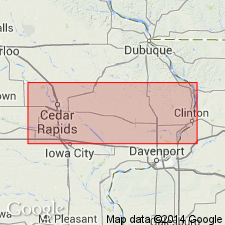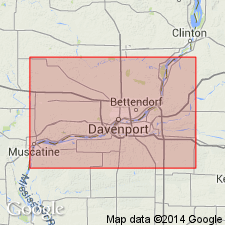
- Usage in publication:
-
- Scotch Grove Formation
- Modifications:
-
- Named
- Dominant lithology:
-
- Dolomite
- Chert
- AAPG geologic province:
-
- Iowa shelf
Summary:
The Scotch Grove Formation, described as an informal rock unit by Witzke (1981: Geological Society of Iowa, Guidebook 35, 38 p.) is here formally named and defined as the interval of rocks above the Picture Rock Member of the Hopkinton Formation and below the base of the first laminated and mounded dolomites of the Gower Formation in eastern IA. The original definitions of both the Hopkinton and Gower are preserved with the introduction of the Scotch Grove Formation. Includes six members (ascending): Johns Creek Quarry, Welton, and Buck Creek Quarry Member of Johnson (1983), here reassigned from the upper part of the revised Hopkinton Formation, and the Fawn Creek, Waubeek, and Palisades-Kepler Members (all new names). Consists of a variety of carbonate facies including flat-lying and mounded, dense and porous, cherty and non-cherty, sparsely fossiliferous and crinoid-moldic dolomite. Lower and upper contacts are conformable and sharp; the upper contact may be locally disconformable. Thickness ranges from 100 to 300 ft. Age is Early Silurian (Llandoverian and Wenlockian).
Source: GNU records (USGS DDS-6; Reston GNULEX).

- Usage in publication:
-
- Scotch Grove Formation
- Modifications:
-
- Areal extent
- AAPG geologic province:
-
- Iowa shelf
- Wisconsin arch
Summary:
According to author, one of his primary aims in this report is to strongly encourage adoption of IA nomenclature in adjacent IL. The only major change is the incorporation of the Sweeney and Marcus as members within the Hopkinton and replacement of the Racine with upper members of the Hopkinton, the Scotch Grove Formation, and the Gower Formation. The Scotch Grove occurs entirely in the subsurface in the Quad Cities area. It ranges between 120 and 150 ft in thickness in the study area, but thickens to the northwest, reaching 300 ft. Bulk of the formation is characterized by fossil-moldic dolomite with denser less fossiliferous units at the top band bottom. Is generally non-cherty in the area, but becomes more chert-rich westward. Members of the Scotch Grove recognized in the eastern IA and western IL Quad Cities area are the basal Johns Creek Quarry Member, the Welton Member (which composes the bulk of the formation), and the Waubeek Member. The extent of the Palisades-Kepler Member in the study area is not known. The Buck Creek Quarry Member appears to be restricted to the area west of the Quad Cities and the Fawn Creek Member is not mentioned in the text and does not appear in the figures. Age of the Scotch Grove is late Llandoverian to late early or mid Wenlockian.
Source: GNU records (USGS DDS-6; Reston GNULEX).
For more information, please contact Nancy Stamm, Geologic Names Committee Secretary.
Asterisk (*) indicates published by U.S. Geological Survey authors.
"No current usage" (†) implies that a name has been abandoned or has fallen into disuse. Former usage and, if known, replacement name given in parentheses ( ).
Slash (/) indicates name conflicts with nomenclatural guidelines (CSN, 1933; ACSN, 1961, 1970; NACSN, 1983, 2005, 2021). May be explained within brackets ([ ]).

